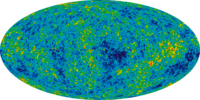
Photo from wikipedia
If dark matter is millicharged or darkly charged, collective plasma processes may dominate momentum exchange over direct particle collisions. In particular, plasma streaming instabilities can couple the momentum of the… Click to show full abstract
If dark matter is millicharged or darkly charged, collective plasma processes may dominate momentum exchange over direct particle collisions. In particular, plasma streaming instabilities can couple the momentum of the dark matter to counter-streaming baryons or other dark matter and result in the counter-streaming fluids coming to rest with each other, just as happens for baryonic collisionless shocks in astrophysical systems. While electrostatic plasma instabilites (such as the two-stream) are highly suppressed by Landau damping when dark matter is millicharged, in the cosmological situations of interest, electromagnetic instabilities such as the Weibel can couple the momenta, assuming that the linear instability saturates in the manner typically found for baryonic plasmas. We find that the streaming of dark matter in the pre-Recombination universe is affected more strongly by direct collisions than collective processes, validating previous constraints. However, when considering unmagnetized instabilities the properties of the Bullet Cluster merger and other merging cluster systems (which show dark matter streaming through itself) are likely to be substantially altered if [qχ /mχ ] ≳ 10-4, where [qχ /mχ ] is the charge-to-mass ratio of the dark matter relative to that of the proton. When a magnetic field is added consistent with cluster observations, the Weibel and Firehose instabilities result in sufficiently fast growth to reach saturation for [qχ /mχ ] ≳ 10-12–10-11. The Weibel growth rates are even faster in the case of a dark-U(1) charge (because “hot” electrons do not damp the instability), potentially ruling out [qχ /mχ ] ≳ 10-14 in the Bullet Cluster system, in agreement with [1]. The strongest previous limits on millicharged dark matter (mDM) arise from considering the spin-down of galactic disks [2]. We show that plasma instabilities or tangled background magnetic fields could lead to diffusive propagation of the dark matter, weakening these spin-down limits. Thus, plasma instabilities may place some of the most stringent constraints over much of the millicharged, and our results corroborate previous extremely stringent potential constraints on the dark-charged parameter space.
Journal Title: Journal of Cosmology and Astroparticle Physics
Year Published: 2022
Link to full text (if available)
Share on Social Media: Sign Up to like & get
recommendations!